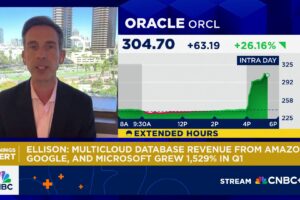
Nvidia is soaring now, but could its dominance fade in the next few years? Two tech titans could outshine Nvidia by 2029.
Semiconductor designer Nvidia (NVDA 0.39%) is enjoying a golden age right now. The company has cornered the market for high-end accelerator chips used in training and running modern artificial intelligence (AI) systems. With a $3.4 trillion market cap on Dec. 23, 2024, Nvidia is (checks notes) the second-most valuable stock on the market today, behind only Apple at $3.9 trillion.
Nvidia may soar even higher as the generative AI boom plays out, but things might change in a few years. Whether Nvidia’s stock doubles or drops in two or three years, it could very well be back at today’s price levels — or a bit lower — by the end of the decade. Meanwhile, I expect fellow “Magnificent Seven” stocks Alphabet (GOOG 0.81%) (GOOGL 0.76%) and Amazon (AMZN 1.77%) to build shareholder value in a more sustainable and predictable way, passing Nvidia’s market value before the end of December 2029.
How Amazon and Alphabet build shareholder value
There’s nothing controversial about the idea that e-commerce pioneer Amazon and Google parent Alphabet should become more valuable over time.
These innovators have a knack for changing with the times, occasionally creating brand-new business concepts and leading the charge into whatever comes next. I can’t claim that Amazon invented cloud computing or same-day shipping services, but it built successful businesses around them before anybody else. Likewise, the company formerly known as Google embraced video-based social media and smartphones before they were cool. YouTube and Android are still leaders in those fields, many years later.
Their target markets keep changing, usually due to macroeconomic shifts. The coronavirus pandemic boosted the business value of online retail stores and cloud computing solutions; Alphabet and Amazon soared as a result.
When the health crisis subsided and people trickled back into their offices, the digital boom faded out, but these tech titans simply evolved. Both are leading names in the AI market, Amazon’s overly enthusiastic shipping infrastructure upgrades gave the company a unique competitive advantage even in slower e-commerce times, and Alphabet is exploring a ton of alternative business ideas.
So I expect their growth stories to develop for the foreseeable future. Your average analyst currently expects Alphabet’s earnings to show a compound annual growth rate (CAGR) of 16% over the next five years. Amazon’s bottom-line CAGR estimates stand at 18% for the same period.
If Wall Street’s growth estimates are in the right ballpark, their earnings (and market value) could more than double by the end of 2029. In other words, Amazon and Alphabet could be worth roughly $5 trillion in five years.
Nvidia’s skyrocketing rise may not last
So far, so perfectly ordinary. Amazon and Alphabet should gain value in the long run, perhaps a bit faster than the S&P 500 (^GSPC 1.10%) market index and other trackers of the stock market’s overall health. The sky is also blue, and water is wet. Film at 11!
But why do I expect Nvidia’s rising star to grow dimmer over the same time span?
Simply put, I think that the market has already accounted for several years of market-beating AI chip sales in Nvidia’s current stock price. It’s a pretty speculative stock these days, trading at 30 times sales and 54 times earnings. Rising any higher from this lofty point will require Nvidia to hold on to its dominant AI-chip market share, deliver massive unit volumes to its customers, and maintain its very lucrative chip prices as well.
Obstacles to Nvidia’s future dominance
And there are serious challenges to overcome along the way. Here are some factors to consider:
- Rivals such as Advanced Micro Devices (AMD 1.36%) and Broadcom (AVGO 3.15%) already have highly competitive AI accelerators available. And did you know that Alphabet and Amazon have developed proprietary AI chips to fit their specific software requirements, too? Nvidia’s iron grip on this market might loosen over time.
- Nvidia relies on third-party manufacturing services to turn its semiconductor blueprints into physical products. So do AMD, Broadcom, and almost the whole chip sector. The company competes for a limited amount of production capacity and materials, and may not always be able to fill every order on time. Remember the chip manufacturing shortage of 2020-2023? That could happen again, undermining Nvidia’s high-flying market value.
- These two challenges could add pricing pressure to the AI chip market. Nvidia’s 76% gross margin suggests a monopoly, and the actual market should be healthier than that.
So Nvidia could keep rising in a speculative way for another year or two. Maybe, perhaps, conceivably. But you know what master investor Benjamin Graham said about the stock market — it’s a popularity contest in the short run and a weighing machine in the long term.
You’re watching Nvidia’s “popularity” phase right now, and I’m not sure when it will peak. The “true value” phase could look very different, as outlined here. Meanwhile, Alphabet and Amazon strike me as really safe long-term bets with predictable stock gains in the years ahead.
John Mackey, former CEO of Whole Foods Market, an Amazon subsidiary, is a member of The Motley Fool’s board of directors. Suzanne Frey, an executive at Alphabet, is a member of The Motley Fool’s board of directors. Anders Bylund has positions in Alphabet, Amazon, and Nvidia. The Motley Fool has positions in and recommends Advanced Micro Devices, Alphabet, Amazon, Apple, and Nvidia. The Motley Fool recommends Broadcom. The Motley Fool has a disclosure policy.








